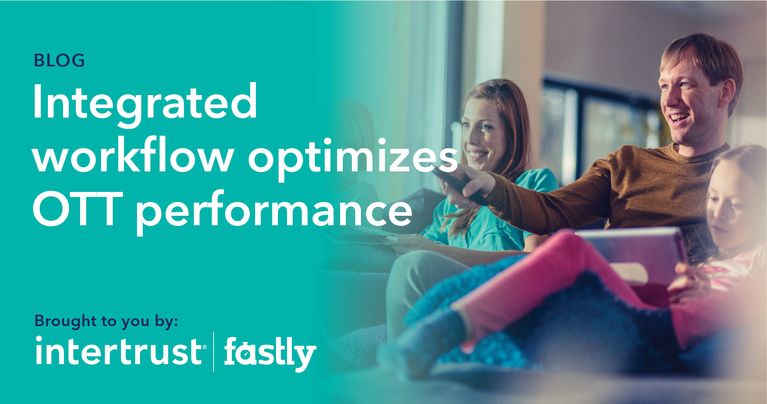Living in unprecedented times
The COVID-19 pandemic is putting pressure on society in innumerable ways, ranging from first responders, to hospital facilities and government agencies, to families and individuals “sheltering in place.” Streaming service providers have experienced a surge in new customer sign-ups combined with extended viewing throughout daytime and evenings. Netflix added 15.8 million subscribers, more than double the 7.2 million that were expected, during Q1 2020. As state policies were put in place, research conducted by Fastly revealed a substantial increase in traffic load in several industry verticals including, digital publishing, social media, GIFs, gaming, education, and streaming. For streaming services specifically, between February and March there was an observed increase of 29.6% in average requests per second.
The OTT challenge
OTT-delivered video is viewed and enjoyed on a wide variety of client devices and players, ranging from smartphones and tablets to Ultra HD capable and large-screen TV sets. Consequently, service providers must support several codec and container formats, operating systems, adaptive bitrate protocols and digital rights management (DRM) systems, and more. This fragmentation of the client device universe means that service providers face a daunting content processing workflow challenge to say the least.
The global surge in online video viewing has also witnessed a significant increase in media piracy. It is now more important than ever to apply a high-grade content protection solution that can stand up to increasingly sophisticated media pirates and hackers.
The solution
To address these OTT challenges during this time of unprecedented viewership, Fastly, Inc. (NYSE: FSLY; HQ: San Francisco, California) and Intertrust Technologies have partnered to offer a joint solution for streamlining packaging and playback of protected content. The fully integrated direct-to-consumer (DTC) solution comprises Fastly’s on-the-fly packaging (OTFP) service and Intertrust’s ExpressPlay multi-DRM service. Content is encrypted and packaged seamlessly, so operators do not need to concern themselves with the encryption workflow. Moving these traditionally offline DRM workflows to the edge of the network helps streamline internal processes and reduce operational and infrastructure costs, all while enabling the use of popular media players or native/HTML5 players.
Fastly’s edge cloud platform
Fastly’s edge cloud platform is designed to cache and rapidly deliver both frequently requested and long-tail, on-demand videos. By moving data and applications as close to the end-users as possible, operators can deliver fast, highly personalized experiences to viewers around the world. The company’s modern network architecture and edge cloud capabilities, such as request collapsing and load balancing, provide a crucial advantage by supporting live and high-volume traffic with minimum lag and latency.
Fastly offers an “on-the-fly,” dynamic, VOD content packaging service. Rather than requiring the operator to pre-package the video, the content is packaged in real time and immediately made available to viewers. Fastly supports both HLS (Envelope AES and Sample AES Encryption) as well as MPEG-DASH Common Encryption (CENC).
Overcoming the OTT bottlenecks
The Fastly and Intertrust joint solution provides a one-stop highly scalable, simplified and secure workflow for packaging and delivery of protected content with studio-approved security and minimal latency, to virtually any device. The integrated solution means that OTT operators do not need to concern themselves with managing keys, content packaging, encryption and secure delivery.
The service is illustrated below, showing how the Fastly OTFP interacts with the content management system (CMS) and the ExpressPlay multi-DRM service to deliver DRM-protected content to the end user (viewer):
- A user selects a specific video resulting in a request for an Asset ID and associated license token
- The app authenticates and requests the license token for the user’s content rights
- Fastly requests both Content Encryption Key (CEK) and license tokens for the user’s content rights from the Intertrust ExpressPlay DRM service
- The app or media player redeems a license using the token
- The encrypted video is delivered and decrypted by the user’s device for local viewing
The keys used by Fastly’s OTFP service are securely stored in the ExpressPlay DRM KMS, which is fully integrated with the ExpressPlay DRM License service to support all major DRM systems including Apple FairPlay Streaming, Google Widevine, Microsoft PlayReady, Adobe Access/Primetime, and the open-standard Marlin DRM.
The solution supports both OTT live events and on-demand use cases. It enables operators to address audiences on a global scale as proven in large deployments in Asia and Europe. The joint solution enables operators to:
- Configure live stream delivery, enabling millions of concurrent users across all HTTP streaming standards
- Secure HTTP streaming with token authentication, content targeting, and media encryption
- Deliver the best possible experience regardless of user location, device, or connection
- Update catalog content instantly and save on costs serving long-tail content with dynamic packaging
Operators can thus be confident in their content distribution infrastructure and security, allowing them to focus on their core business, improving overall competitiveness and providing consumers with a great experience in these unprecedented times.
For further information, please download the joint solution brief.








